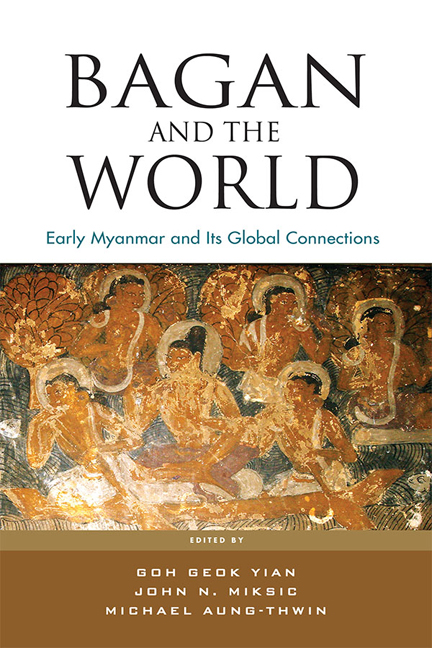Book contents
- Frontmatter
- Contents
- Preface
- Contributors
- 1 Keynote: The Myth of “Splendid Isolation”
- 2 Analysis of Construction Technologies in Pyu Cities and Bagan
- 3 Khraung-kaik Pitaka-taik: 16th-Century Repositories for Buddhist Scriptures in Mrauk-U
- 4 Religious Symbols as Decorations on the Sikhara of Ancient Monuments in the Late Bagan Period
- 5 The Viṣṇu on Garuḍa from the Nat Hlaung Kyaung Temple, Bagan
- 6 A Thousand Years before Bagan: Radiocarbon Dates and Myanmar's Ancient Pyu Cities
- 7 Ta Mok Shwe-Gu-Gyi Temple Kyaukse and Bagan
- 8 Silver Links! Bagan–Bengal and Shadowy Metal Corridors: 9th to 13th Centuries
- 9 Positioning Bagan in the Buddhist Ecumene: Myanmar's Trans-Polity Connections
- 10 Orthogeneity, Settlement Patterns and Earthenware Pottery Distribution in Bagan
- Index
- Miscellaneous Endmatter
3 - Khraung-kaik Pitaka-taik: 16th-Century Repositories for Buddhist Scriptures in Mrauk-U
Published online by Cambridge University Press: 01 February 2018
- Frontmatter
- Contents
- Preface
- Contributors
- 1 Keynote: The Myth of “Splendid Isolation”
- 2 Analysis of Construction Technologies in Pyu Cities and Bagan
- 3 Khraung-kaik Pitaka-taik: 16th-Century Repositories for Buddhist Scriptures in Mrauk-U
- 4 Religious Symbols as Decorations on the Sikhara of Ancient Monuments in the Late Bagan Period
- 5 The Viṣṇu on Garuḍa from the Nat Hlaung Kyaung Temple, Bagan
- 6 A Thousand Years before Bagan: Radiocarbon Dates and Myanmar's Ancient Pyu Cities
- 7 Ta Mok Shwe-Gu-Gyi Temple Kyaukse and Bagan
- 8 Silver Links! Bagan–Bengal and Shadowy Metal Corridors: 9th to 13th Centuries
- 9 Positioning Bagan in the Buddhist Ecumene: Myanmar's Trans-Polity Connections
- 10 Orthogeneity, Settlement Patterns and Earthenware Pottery Distribution in Bagan
- Index
- Miscellaneous Endmatter
Summary
To study Myanmar history, we need to examine chronicles, archaeological evidence, historical reports and studies, surveys and interviews with local people, among other sources. The Rakhine region is part of an ancient civilization which comprised several flourishing city states rich in cultural heritage. Chronicles mentioned that the Rakhine kingdoms, contemporaries of Burmese polities, were settled systematically by kings since the first century ce. An example was Dhanyawadi City. Rakhine kingdoms existed prior to the Mrauk-U period, which ended in 1785 ce. Each dynasty left an invaluable cultural heritage which showcased its glory and prosperity. This chapter examines the establishment of libraries in Mrauk-U connected with the propagation of Buddhism in the region between the 15th and 18th centuries.
A Brief History of Mrauk-U
Mrauk-U city is the most important archaeological heritage of the Rakhine people. Mrauk-U, which means “plentifully perceived foremost to be completely successful”, was Rakhine's last powerful kingdom. It represented the zenith of cultural values for the Rakhine people, and flourished from 1430 to 1785 CE (Rakhine State People Council 1988,p. 7).
The golden age of Mrauk-U was the 16th and 17th centuries, contemporary with the Tudor kings, Queen Elizabeth I and Shakespeare in England, the Moghuls in India, the Ayutthaya kings in Siam, and the kingdoms of Ava (lnwa), Taungngu and Hanthawaddy of Myanmar (Rakhine State People Council 1988, p. 8). U May Oung provides a chronology of Myanmar kingdoms based on various historical accounts of Myanmar and archaeological reports (May Oung 1912, p. 9).
Archaeological evidence from excavations of Dhanyawadi city provides much information on the period beginning with the 1st century ce. Excavations revealed irregular circular brick city walls, a moat, and the palace site. After Dhanyawadi, the Chandra Dynasty established the Vesali kingdom in the middle of the fourth century ce. U Pandi's Dhanyawadi Yazawinthit (New Dhanyawadi history) states that Vesali was founded in 790 ce, several decades before Bagan was built in 849 ce. Archaeological evidence from the Vesali site includes Buddha images, stupas, metal materials, inscriptions, et cetera. During the reign of the last Chandra king, Sula Chandra, Vesali became weak and was succeeded by a kingdom centred in the Lemro valley (Rakhine State People Council 1988, p. 8).
- Type
- Chapter
- Information
- Bagan and the WorldEarly Myanmar and Its Global Connections, pp. 45 - 56Publisher: ISEAS–Yusof Ishak InstitutePrint publication year: 2017



